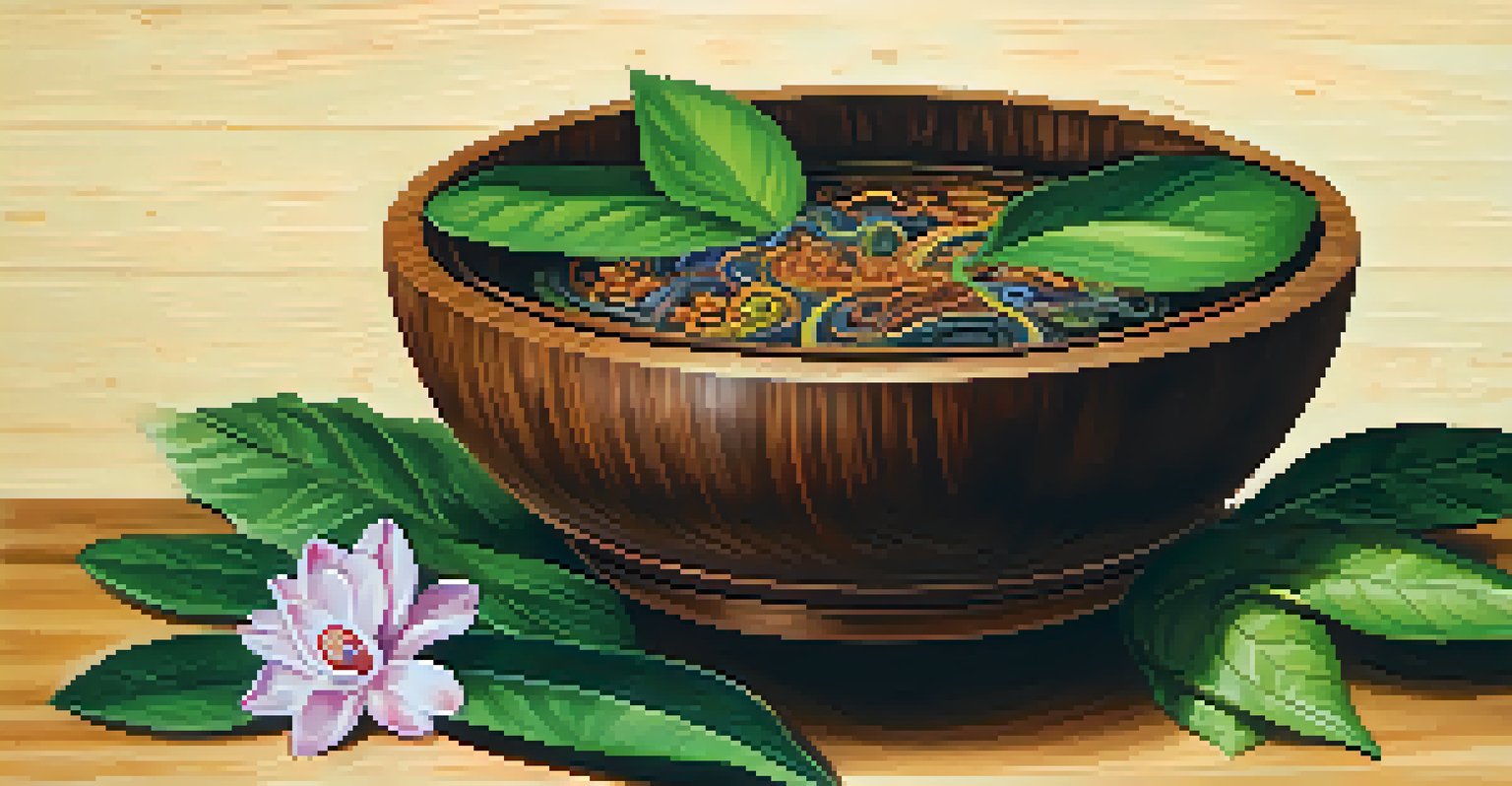Cultural Significance of Ayahuasca in Indigenous Communities

Understanding Ayahuasca: A Sacred Plant Medicine
Ayahuasca is a powerful brew made from the Banisteriopsis caapi vine and other plants, traditionally used by Indigenous communities in the Amazon. This sacred medicine is known for its psychoactive properties, primarily due to the presence of DMT, which induces profound spiritual experiences. For many, it serves not only as a tool for healing but also as a means to connect with the spirit world, providing insights and clarity that transcend ordinary consciousness.
The experience of Ayahuasca is not just a means of healing; it’s a doorway to a deeper understanding of ourselves and our connection to the universe.
In these cultures, Ayahuasca ceremonies are deeply rooted in ancestral traditions, often led by experienced shamans who guide participants through their journeys. The ceremonies typically take place in a ceremonial setting, emphasizing respect and intention, and are accompanied by specific songs known as 'icaros.' These songs are believed to enhance the healing process and help participants navigate their experiences.
The significance of Ayahuasca goes beyond individual healing; it's a communal event that fosters connection among participants. This shared experience can strengthen social bonds and reinforce cultural identity, making it an integral part of community life for many Indigenous groups.
Ayahuasca as a Tool for Healing and Wellness
Within Indigenous cultures, Ayahuasca is often utilized for its healing properties, addressing both physical and mental ailments. Many participants report experiencing emotional release, clarity, and relief from trauma during their journeys. This medicinal aspect is crucial, as it provides an alternative approach to health that contrasts sharply with Western medicine's often more clinical methods.

Shamans, viewed as healers and spiritual guides, play a vital role in this process. They possess extensive knowledge of the plants used in the brew and the intricate rituals surrounding Ayahuasca ceremonies. This expertise allows them to tailor experiences to individual needs, ensuring that participants receive the support necessary for their healing journeys.
Ayahuasca's Healing Power
Ayahuasca is used by Indigenous communities for its profound healing properties, addressing both physical and mental ailments.
Moreover, the holistic approach to healing in these communities emphasizes the interconnectedness of body, mind, and spirit. By addressing issues on multiple levels, Ayahuasca invites participants to explore the root causes of their suffering, offering a comprehensive path toward wellness.
Cultural Identity and the Role of Ayahuasca
Ayahuasca is not merely a substance; it's a cornerstone of cultural identity for many Indigenous peoples. The rituals and practices surrounding its use are steeped in history and tradition, reflecting the values and beliefs of these communities. As a result, participating in Ayahuasca ceremonies can reinforce an individual's connection to their heritage and foster a sense of belonging.
To understand the power of Ayahuasca, one must approach it with respect and an open heart, recognizing its roots in ancient wisdom and community.
In this context, the brew symbolizes a bridge between the physical and spiritual realms, allowing practitioners to engage with their ancestry and cultural narratives. This engagement is crucial, as it helps preserve Indigenous knowledge and traditions that might otherwise be lost in a rapidly globalizing world.
Furthermore, as interest in Ayahuasca grows beyond Indigenous communities, there is an ongoing dialogue about cultural appropriation. Many Indigenous leaders emphasize the importance of respecting the origins and significance of Ayahuasca, advocating for responsible use that honors their traditions.
The Spiritual Dimensions of Ayahuasca Ceremonies
Engaging with Ayahuasca is often described as a spiritual journey, where participants seek deeper understanding and connection to the universe. During ceremonies, individuals may encounter visions and experiences that provide insights into their lives and the world around them. These experiences are typically viewed as sacred and transformative, leading to personal growth and enlightenment.
The spiritual dimension of Ayahuasca is intricately linked to the beliefs held by Indigenous communities. Many view the brew as a means to communicate with spirits and ancestors, bridging the gap between the living and the departed. This connection is often facilitated by the shaman, who serves as a mediator between the two worlds.
Cultural Significance of Ayahuasca
The brew serves as a cornerstone of cultural identity, connecting individuals to their heritage and reinforcing communal bonds.
Through these experiences, participants often gain a renewed sense of purpose and clarity regarding their life paths. The insights gained during these journeys can lead to profound changes, encouraging individuals to live in alignment with their values and cultural teachings.
Modern Challenges Facing Indigenous Ayahuasca Practices
As interest in Ayahuasca spreads globally, Indigenous communities face several challenges in preserving their traditional practices. The commercialization of Ayahuasca retreats and the influx of tourists can sometimes dilute the authenticity of the ceremonies, leading to concerns about exploitation and cultural appropriation. This shift can undermine the spiritual and communal significance that these practices hold.
Additionally, the increasing popularity of Ayahuasca raises questions about sustainability and the environmental impact of harvesting the necessary plants. Indigenous communities often rely on their local ecosystems, and overharvesting can threaten these vital resources, leading to a cascade of ecological consequences.
In response, many Indigenous leaders are advocating for greater recognition and respect for their cultural practices. By promoting education and awareness, they aim to ensure that the essence of Ayahuasca ceremonies is preserved while navigating the complexities of modern society.
The Role of Education in Ayahuasca Awareness
Education plays a pivotal role in fostering respect for Ayahuasca and the cultures that have nurtured it for generations. By understanding the history and significance of Ayahuasca, individuals can approach their experiences with the necessary reverence and mindfulness. This awareness can help bridge the gap between Indigenous and non-Indigenous perspectives, promoting mutual respect.
Workshops, documentaries, and literature about Ayahuasca can serve as informative resources, shedding light on its cultural roots and spiritual dimensions. These educational initiatives not only empower participants but also encourage them to engage with Indigenous communities in respectful and meaningful ways.
Challenges of Modern Interest
The growing global interest in Ayahuasca presents challenges, including commercialization and the risk of cultural appropriation.
Furthermore, education can help combat the misconceptions surrounding Ayahuasca, positioning it as a sacred practice rather than just a recreational substance. By fostering a deeper understanding of its significance, we can support the preservation of Indigenous culture and the integrity of Ayahuasca ceremonies.
Future of Ayahuasca in Indigenous Cultures
Looking ahead, the future of Ayahuasca in Indigenous cultures will likely hinge on a delicate balance between tradition and modernity. As more people seek out Ayahuasca experiences, Indigenous communities have the opportunity to share their knowledge and practices while advocating for their rights and cultural integrity. This exchange can lead to greater appreciation for traditional practices and the wisdom they offer.
However, it is essential for Indigenous leaders to maintain control over their cultural heritage and ensure that Ayahuasca practices remain rooted in their spiritual and communal significance. By establishing guidelines and protocols, they can protect the authenticity of their ceremonies and prevent the dilution of their cultural identity.

In this evolving landscape, collaboration between Indigenous communities and those interested in Ayahuasca can foster a deeper understanding and respect for its cultural significance. Together, they can pave the way for a future where Ayahuasca serves as a bridge between cultures, enriching the spiritual journeys of all involved.